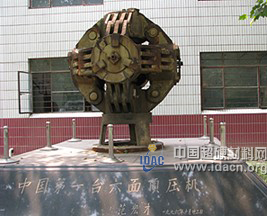In April 1965, the First Ministry of Machinery Industry officially issued the "Procedures on the Intermediate Test Plan for Synthetic Diamonds," approved by the State Science and Technology Commission. This plan required the establishment of a synthetic diamond intermediate test base at the Abrasives Grinding Research Institute (commonly known as Sanmao). The project aimed to develop and refine the process of creating artificial diamonds through high-pressure and high-temperature synthesis.
The participating institutions included the Zhengzhou Sanmao Institute, Jinan Casting and Forging Institute, and the Shanghai Materials Research Institute. Each played a key role in different aspects of the development: Sanmao was responsible for the synthesis process, raw material processing, and product sorting, while also conducting research on physical and chemical testing methods. Jinan Casting and Forging took charge of designing and producing the six-faced ultra-high pressure synthesis equipment. Hu Enliang from the General Machinery Research Institute had already designed two sets of presses—6×300 tons and 6×600 tons—as early as 1963. In June 1964, he handed over the blueprints to Jinan Casting and Forging, providing the technical foundation for their production.
Meanwhile, the Shanghai Materials Research Institute focused on developing alloy anvils used in the synthesis process. In August 1965, with close collaboration between Sanmao and Jinan Casting and Forging, China's first hinged six-sided ultra-high pressure and high-temperature diamond synthesis device, the 6×6MN DS-023, was successfully developed. Researchers from Sanmao, including Wang Guangzu, Yu Zhengmin, Yu Zhichao, Li Jinbao, Shao Dehou, Yan Juwu, and Kong Lingchun, conducted initial diamond synthesis tests in Jinan.
On November 5, 1965, the first diamond was synthesized using this device, marking a major milestone in China’s development of synthetic diamond technology. After six months of testing and refining the process, the system became stable. On June 7, 1966, the six-sided synthesis apparatus was moved from Jinan to Zhengzhou’s Third Mill, arriving on the 10th.
In July 1966, the intermediate test work on man-made diamond synthesis was completed. By that year, the facility produced 10,000 carats of diamonds. In October 1966, the Ministry of Machinery Industry approved the construction of China’s first synthetic diamond plant—the Sixth Grinding Wheel Factory—in Guiyang, Guizhou Province. Sanmao provided complete process design and technical support, as well as personnel training, marking the start of industrial-scale production of synthetic diamonds in China.
In 1996, when Zhengzhou Sanmao established the National Engineering Technology Research Center for Superhard Materials and Products, the historic press was preserved as an important cultural relic in No. 121 Huashan Road. During the acceptance of the center, Mr. Fan Hongcai, then chief engineer of the Ministry of Machinery Industry, inscribed “China’s First Six-Sided Press†on the machine.
Commissioned in 1965, the press operated for 30 years before being retired in 1995. It was used to synthesize diamonds over 1.5 million times and was honored as a meritorious press.
See photo one.

When Zhengzhou Sanmao relocated to No. 121 Wutong Street in the Zhengzhou High-tech Industrial Development Zone in 2010, the press was moved along with it and is now displayed in the courtyard of the Zhengzhou Abrasives Grinding Research Institute.
See photo two.

**Photo 2: China's first hinged six-sided diamond synthesis press**
Manual Hydraulic Pump
A manual Hydraulic Pump is a device used to generate hydraulic pressure manually. It is typically used in applications where a power source is not available or where precise control of pressure is required.
The pump consists of a handle or lever that is manually operated by the user. When the lever is moved, it activates a piston or plunger inside the pump, which pressurizes the hydraulic fluid. The pressurized fluid is then directed to the hydraulic system through a series of valves and hoses.
There are different types of manual hydraulic pumps, including hand pumps, foot pumps, and air-powered pumps. Hand pumps are the most common type and are operated by hand-cranking a lever or rotating a handle. Foot pumps are operated by stepping on a pedal or lever with the foot. Air-powered pumps use compressed air to generate hydraulic pressure and are often used in industrial applications.
Manual hydraulic pumps are commonly used in a variety of industries, including automotive, construction, and manufacturing. They are used to power hydraulic tools, lift heavy objects, and operate hydraulic machinery. They are also used in hydraulic testing and calibration applications, where precise control of pressure is required.
Overall, a manual hydraulic pump is a versatile and reliable tool that allows for the generation of hydraulic pressure without the need for an external power source.
Manual Hydraulic Pump,Manual Hydraulic Hand Pump,Hand Operated Hydraulic Pump,High Pressure Hydraulic Manual Pump
Yantai Dongyue Hydraulic Technology Co., Ltd , https://www.deeleap.com